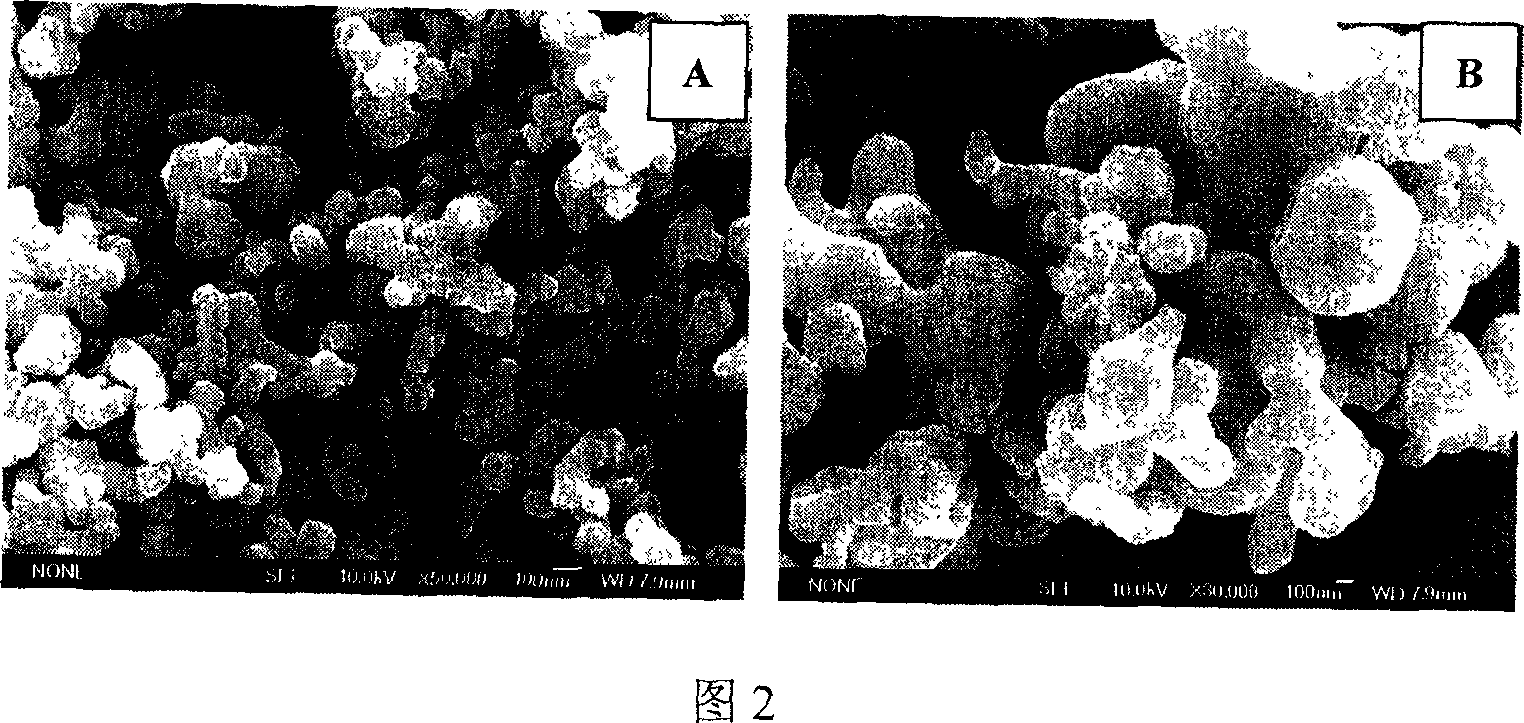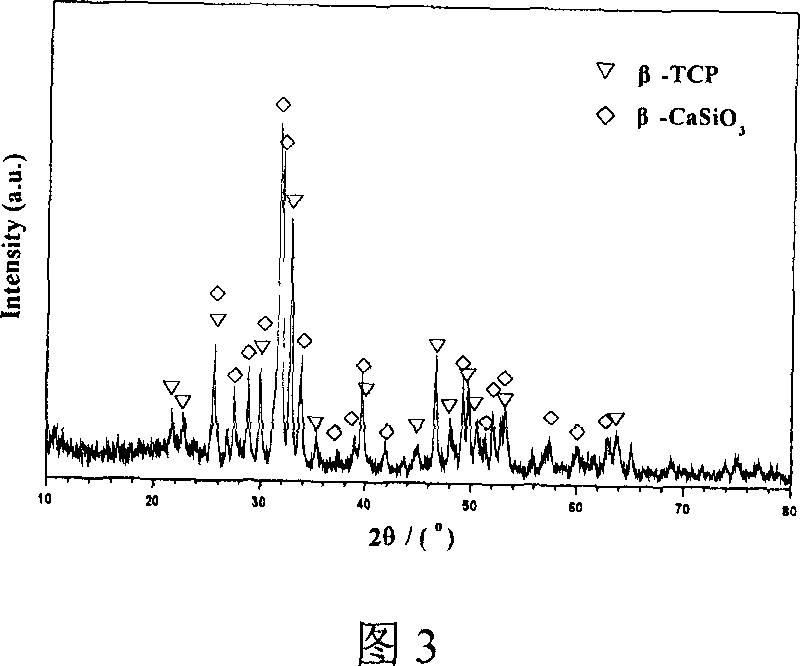Method for preparing calcium silicate/beta- tricalcium phosphate composite powder by in situ chemical precipitation method
A technology of tricalcium phosphate and composite powder, which is applied in the field of biomedical materials, can solve the problems of cumbersome washing, complexity, and long time, and achieve the effect of simple and easy preparation process, controllable composite ratio, and uniform composite degree
- Summary
- Abstract
- Description
- Claims
- Application Information
AI Technical Summary
Problems solved by technology
Method used
Image
Examples
Embodiment 1
[0031] Take 216.05 grams of Ca(NO 3 ) 2 4H 2 O was dissolved in deionized water to prepare a 0.5mol / L aqueous solution, and adjusted to pH=11 with 1:1 ammonia water, and 122.50 grams of Na 2 SiO 3 9H 2 O and 42.60 g of (NH 4 ) 2 HPO 4 Dissolve in deionized water to prepare a 0.5 mol / L aqueous solution, and adjust pH=11. The above Ca(NO 3 ) 2 solution added to Na 2 SiO 3 and (NH 4 ) 2 HPO 4 In the mixed solution, the pH value of the reaction system was maintained at 11 with 1:1 ammonia solution during the feeding process, and the stirring was continued for 24 hours after the addition, filtered and washed to obtain a wet powder, and the wet powder was dried at 80°C for 12 hours to obtain The dry powder is calcined at 800°C for 2 hours to obtain a uniform composite calcium silicate / β-tricalcium phosphate composite powder with a mass percentage of 50:50. The morphology of the prepared composite powder is shown in Figure 2A, and the size is about 80-100 nanometers; t...
Embodiment 2
[0033] The raw materials used are as described above.
[0034] Take 216.05 grams of Ca(NO 3 ) 2 4H 2 O was dissolved in deionized water to prepare a 2.0mol / L aqueous solution, and adjusted to pH=11 with 1:1 ammonia water, and 122.50 grams of Na 2 SiO 3 9H 2 O and 42.60 g of (NH 4 ) 2 HPO 4 Dissolve in deionized water to prepare a 2.0 mol / L aqueous solution, and adjust the pH to 11 with 1:1 ammonia water. The above Ca(NO 3 ) 2 solution added to Na 2 SiO 3 and (NH 4 ) 2 HPO 4 In the mixed solution, the pH value of the reaction system was maintained at 11 with a 1:1 ammonia solution during the feeding process, and the stirring was continued for 36 hours after the addition, filtered and washed to obtain a wet powder, and the wet powder was dried at 80°C for 12 hours to obtain The dry powder is calcined at 1000° C. for 2 hours to obtain a uniform composite calcium silicate / β-tricalcium phosphate composite powder with a mass percentage of 50:50. The morphology of the...
Embodiment 3
[0036] The raw materials used are as described above.
[0037] Take 226.04 grams of Ca(NO 3 ) 2 4H 2 O is dissolved in deionized water and prepared as a 0.5mol / L aqueous solution, and adjusted to pH=11 with aqueous sodium hydroxide solution, and 24.50 grams of Na 2 SiO 3 9H 2 O and 76.68 g of (NH 4 ) 2 HPO 4 Dissolve in deionized water to prepare a 0.5 mol / L aqueous solution, and adjust to pH=11 with aqueous sodium hydroxide solution. The above Ca(NO 3 ) 2 solution added to Na 2 SiO 3 and (NH 4 ) 2 HPO 4 In the mixed solution, the pH of the reaction system was maintained at 11 with sodium hydroxide aqueous solution during the feeding process, and the stirring was continued for 12 hours after the addition, filtered and washed to obtain a wet powder, and the wet powder was dried at 80°C for 12 hours to obtain a dry powder. The dry powder was calcined at 800° C. for 1 hour to obtain a uniform composite calcium silicate / β-tricalcium phosphate composite powder with a...
PUM
| Property | Measurement | Unit |
|---|---|---|
| particle size | aaaaa | aaaaa |
| size | aaaaa | aaaaa |
| particle size | aaaaa | aaaaa |
Abstract
Description
Claims
Application Information
 Login to View More
Login to View More - Generate Ideas
- Intellectual Property
- Life Sciences
- Materials
- Tech Scout
- Unparalleled Data Quality
- Higher Quality Content
- 60% Fewer Hallucinations
Browse by: Latest US Patents, China's latest patents, Technical Efficacy Thesaurus, Application Domain, Technology Topic, Popular Technical Reports.
© 2025 PatSnap. All rights reserved.Legal|Privacy policy|Modern Slavery Act Transparency Statement|Sitemap|About US| Contact US: help@patsnap.com



